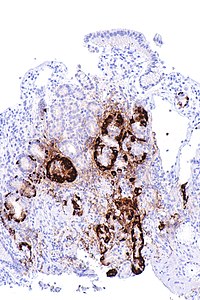
Photo from wikipedia
A 12-week feeding trial was conducted to evaluate the effects of dietary vitamin C on growth performance, antioxidant status and innate immune responses in juvenile yellow catfish, Pelteobagrus fulvidraco. Six… Click to show full abstract
A 12-week feeding trial was conducted to evaluate the effects of dietary vitamin C on growth performance, antioxidant status and innate immune responses in juvenile yellow catfish, Pelteobagrus fulvidraco. Six isonitrogenous and isolipidic diets (44% crude protein and 7% lipid) were formulated to contain six graded dietary vitamin C (ascorbate-2-poly- phosphate, ROVIMIX® STAY-C® 35) levels ranging from 1.9 to 316.0 mg kg−1 diet. The results of present study indicated that fish fed the lowest vitamin C diet had lower weight gain (WG) and specific growth rate (SGR) than those fed the diets supplemented vitamin C. WG and SGR did significantly increase with dietary vitamin C levels increasing from 1.9 to 156.5 mg kg−1. However, no significant increase was observed with further dietary vitamin C levels increasing from 156.5 to 316 mg kg−1. Survival, protein efficiency ratio and feed efficiency were not significantly affected by the dietary vitamin C levels. The activities of serum superoxide dismutase, catalase and glutathione peroxidase significantly increased when dietary vitamin C levels increased from 1.9 to 156.5 mg kg−1, fish fed the lowest vitamin C diet had higher serum malondialdehyde content than those fed the diets supplemented with vitamin C. Fish fed the diet containing 156.5 mg kg−1 vitamin C had the highest lysozyme, total complement activity, phagocytosis index and respiratory burst of head kidney among all treatments. The challenge test with Aeromonas hydrophila indicated that lower cumulative survival was observed in fish fed the lowest vitamin C diet. Analysis by broken-line regression of SGR and lysozyme activity indicated that the dietary vitamin C requirement of juvenile yellow catfish was estimated to be 114.5 and 102.5 mg kg−1 diet, respectively.
Journal Title: Aquaculture Research
Year Published: 2017
Link to full text (if available)
Share on Social Media: Sign Up to like & get
recommendations!